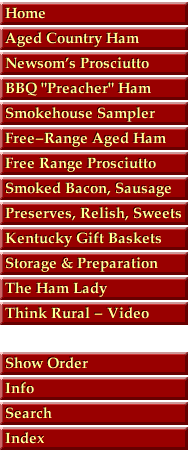
  Ham — Country Ham (salty); City Ham (sweet). Nov. 14, 2005 — Holiday Food The Christmas ham, that glazed, glistening culinary symbol of the holiday, has a kind of Burl Ives quality to it, which only raises the stakes for holiday cooks to get it just right. Ham, technically speaking, is the upper portion of the hind leg of the pig. There are two basic types of ham: city ham and country ham. City hams, also known as wet-cured, are by far the most common hams, the type typically sold in supermarkets. City hams are cured in a solution of salt, water, preservatives (usually including nitrites and nitrates), and various sweet or savory flavorings. Many city hams are also smoked over hardwoods, such as hickory or maple. What you want in a city ham is a whole or half ham, with the bone in. Beyond that, which city ham you choose is a matter of taste. . . . Whole city hams come in sizes ranging from fifteen to seventeen pounds and cost from $2 to $6 per pound. Country hams, also known as dry-cured hams, date to the days before refrigeration, when salting was the only means of preservation. Instead of being wet-cured, country hams are rubbed with a layer of salt and other ingredients and hung to cure for several months. The process is similar to that used for prosciutto. American country hams are usually smoked as well, to add flavor. Country hams can be eaten raw, like prosciutto, but Americans typically prefer them cooked. Cooking a country ham is a chore. Mold that forms on the ham’s surface during the curing process has to be scrubbed off, then the ham has to be soaked for several days, with several changes of water, to release some salt. Finally, the ham has to be boiled or baked. The result can be worth the wait: Country hams have a deep, rich, and intensely salty flavor that hamophiles swear by. Unlike city ham, country ham is best served in small thin slices, traditionally on biscuits — large, thick slices are generally too salty. If you prefer a somewhat less salty country ham, look for one that’s been aged for a relatively short time — the longer the ham is cured, the more salty and intense its flavor. Cooked country hams can be mail-ordered if you don’t want to cook them yourself. A Kentucky outfit called Colonel Bill Newsom’s Country Hams makes a dark-red, salty, deeply flavorful ham, using a recipe from the 1700s. Country hams range in size from fifteen to eighteen pounds and typically cost from $2 to $5 per pound (premium hams like Newsom’s cost more). When buying a city ham, keep the following terms in mind. If the ham is marked plain “ham,” it means no water has been added. Ham “with natural juices” has 7 to 8 percent water added, ham with “water added” has up to 10 percent extra water, and “ham and water product” may contain any amount of water (as the amount of water increases, the quality of the ham decreases). When looking for a city ham, look for a slight layer of fat around the outside. The fat draws off the salt — the more fat, the less salty the ham. When buying a country ham, buy from a reputable producer. Where to Buy. . . Colonel Bill Newsom’s Country Hams are available via mail order (15-to-20-pound bone-in raw ham, $4.39 per pound; sixteen-to-eighteen-pound whole bone-in cooked ham, $85 to $100; 270-365-2482 or newsomscountryham.com). (The prices have been adjusted during the last 19 years as the cost of doing business has increased.) |